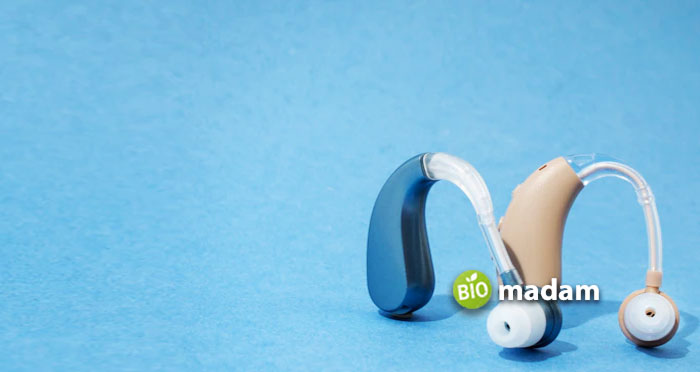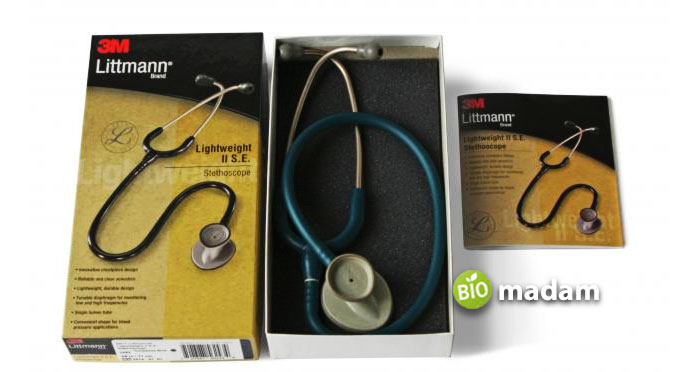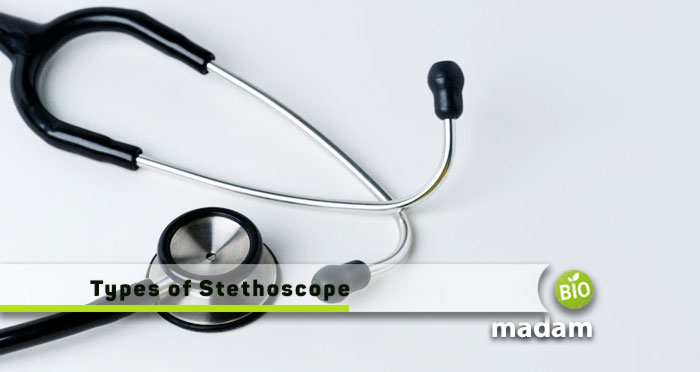Recently updated on January 3rd, 2026 at 06:11 pm
The stethoscope is an instrument well known to the medical fraternity. The long tube-like piece of equipment that doctors use to check your heart rate or breathing rate is the stethoscope. Most doctors in clinics or hospitals carry their stethoscopes around their necks exhibiting the significance of stethoscopes in medicine.
Here’s everything you need to know about stethoscopes and all the types of stethoscopes you can find.
What is a Stethoscope?
The word ‘stethoscope’ is a combination of ‘stethos’ meaning ‘chest’ and ‘scope’ meaning ‘instrument for seeing.’ Thus a stethoscope is an instrument for seeing (observing) the chest (and heart).
Stethoscopes are the primary tool to understand the diagnosis and prognosis of the disease. It allows the doctors to examine the condition of the heart and chest. Evaluating the heart and chest confirms the presence or absence of a serious disease or disorder.
While there are many stethoscopes today to choose from, physicians have always not had a stethoscope to examine their patients. Sounds strange? Keep reading to learn how stethoscopes came into being.
History of Stethoscopes
Observation of the heart and different types of breathing patterns have always been crucial to the medical fraternity. However, before the existence of stethoscopes, doctors examined patients by placing their ears on their chests. It enabled them to understand the condition of the heart and adjacent organs.
One day, a French doctor named ‘Rene Laennec’ had to examine a woman who came to him with a medical complaint. He had to study her heartbeat but did not feel comfortable placing his ear over her chest for diagnosis. He rolled a piece of paper, put one end of the paper to her chest, and listened through the other end. Surprisingly, it worked better than listening to the heartbeat by placing the ear directly. The same year, in 1816, he decided to develop a wooden tube with an earpiece on one end and a bell on the other. His invention became immensely popular in no time, and people from medical backgrounds started using the stethoscope.
25 years after the production of the first wooden stethoscope, George P. Camman introduced a new design with earpieces for both ears instead of one. The doctors were delighted to have this design that offered hearing from both ears for better precision.
Around a century later, Dr. David Littmann patented a new design in the 1960s that changed how stethoscopes looked. This unique design had unmatched acoustical performance listening to the heart and lungs. Dr. Littmann continued working on his designs, and now you can find multiple varieties of stethoscopes.
If you are looking to buy your first microscope, we are happy to share that Littmann stethoscopes are the most trusted stethoscopes globally to examine signs and symptoms.
Parts of Stethoscope
Despite the significant changes in the equipment over the years giving rise to different types of stethoscopes, the basic parts are the same in all.
All stethoscopes contain:
- Ear tips
- Tube
- Stem
- Chest piece
- Diaphragm (for high-frequency sounds)
- Bell (for low-frequency sounds)
Types of Stethoscopes
With the advancements in technology, buying the right stethoscope has become challenging. Different types of stethoscopes have applications in different domains to learn about anatomical and physiological issues in the body. They are categorized based on head types, medical specialty, and advancement.
Types of Head
Single Head
Single-head stethoscopes are the most common types of stethoscopes that have only one circular, flat surface for general use. They are used to listen to vital signs, including the heart and the lungs. The acoustic abilities of single-head stethoscopes are varied and enable doctors to focus on the higher and lower ends.

Dual Head
As the name indicates, dual-head stethoscopes have two heads on each side of the chest piece. One of them is the diaphragm, and the other is the bell. The diaphragm is comparatively flatter and picks up high-frequency sounds. On the other hand, the bell looks like an elongated cup and is better with low-frequency sounds to evaluate asthma and bronchitis. Dual-head stethoscopes are in use by physicians that examine patients of all ages. The diaphragm is better for observing adults, while the bell is more suitable for pediatric patients.
Triple Head
Triple-head stethoscopes are not much prevalent, but they exist. The attachment of three heads to the chest piece makes it rather heavy. Thus, it is only used for critical cardiac, vascular, and pulmonary examination. The triple-head chest piece is typically rotatable for improved comfort.
Advancements
Acoustic Stethoscopes
The most primitive type of stethoscope is the acoustic stethoscope. It channels more sound waves to your ear than you would hear by placing your head on the patient’s chest. When you place the chest piece of the stethoscope on a patient’s chest, heartbeat and breathing create sound ways. When they hit the metal chest piece, the rubber tube channels these sound ways to the eyepiece that transfers them to your ear. The continuous movement of sound waves through the tube ensures more of them reach your ears than without the tube.
Electronic Stethoscopes
The amplification of acoustic stethoscopes is excellent for general-purpose use. However, it might not be enough for improved and complicated diagnostic conditions. Electronic stethoscopes are a level up from acoustic stethoscopes. They translate the vibrations of the sound into electric signals to optimize them for better hearing. These stethoscopes may offer as much as 24 times the amplification of a simple acoustic stethoscope. A certified or registered RT might use electronic stethoscopes to diagnose respiratory diseases including asthma and COPD. More advanced electronic stethoscopes also offer noise-reduction properties for clear listening. Other electronic or digital stethoscopes can also store the tracks, display them on the LCD, or transfer them to other devices through Bluetooth.
One drawback of electronic stethoscopes is that you cannot use them if they run out of batteries or are not charged. Still, its various benefits make it a better choice for many doctors.
Hearing Impaired Stethoscopes
Did you ever think about how hard it is for medical professionals to examine the heart rate of their patients?
Though it would have been difficult in the past, the advancement allows them to examine patients like other doctors. Different electronic stethoscopes come with features that elevate its working, making it easy to study vitals.
Amplified electronic stethoscopes amplify the volume of sound for the hard of hearing. ‘Stethomate tips’ adaptors enable you to use the stethoscope with hearing aids. Furthermore, you can find digital stethoscopes that have an inlet for headphones to record the reading. A transmitter helps wirelessly transmit the sounds from the stethoscope to the hearing aids.

Specialty
Cardiology Stethoscopes
As the name indicates, cardiology stethoscopes are more widely utilized in cardiology to access patients with cardiovascular issues. However, they are not specified only for cardiac uses. This stethoscope delivers high acoustic quality for accurate diagnosis. These stethoscopes have a diaphragm that gives high, and low-frequency sounds without a bell. They can record plasma and blood flow, valve activity, and murmurs.
Moreover, the thick earpiece cancels out extra noise. However, they are more complex and weigh more than traditional stethoscopes. You can find cardiology stethoscopes with a single or double chest piece per choice.
Pediatric Stethoscopes
Pediatric stethoscopes are utilized in assessing young children. They come in different sizes and are typically slightly smaller than adult stethoscopes. The head of a pediatric stethoscope is scaled down to around an inch in diameter to make it suitable for pediatric patients. Pediatric stethoscopes are available in different colors with fun characters to make them child-friendly.
Infant Stethoscopes
The main difference among stethoscopes used for children is the diameter of the head of the instrument. The chest piece of an infant stethoscope is no more than 2.6 cm to obtain accurate observations. They do not contain latex in their construction to avoid different allergic reactions in children.
Neonatal Stethoscopes
Neonatal stethoscopes are specially designed for the smallest patients with the smallest chest piece. Larger chest pieces might cause discomfort to the children and make it difficult to examine the patient. Due to their application in NICU and newborns, the chest piece may be just as wide as two centimeters for accuracy!
Fetocsopes
The fetoscope gets its name from ‘fetus’ and ‘scope.’ Thus, it shows that fetoscopy monitor the movement and heartbeat of the fetus. It is similar to a standard stethoscope, yet it contains a bell-shaped chest piece end to amplify sound waves better. Fetoscopes are not the most preferred stethoscopes to check the fetal heartbeat. Yet, they help understand the fetus’s position through the heartbeat’s sound.
Doppler Stethoscopes
The Doppler stethoscope is analogous to the fetoscope as it is extra sensitive to noise and accurately monitors fetal heart activity. The doctors use Doppler stethoscopes to let the parents hear the heartbeat.
Esophageal Stethoscopes
Esophageal stethoscopes help understand the obstructions or distress to the esophagus and trachea, especially during surgeries. They are used for internal examination of the esophagus under anesthesia. The ultra-thin tube attached to the normal stethoscope observes the condition of the esophagus on the inside.
Veterinary Stethoscopes
Veterinary stethoscopes differ from stethoscopes that help diagnose changes in the body vitals due to infections or diseases in humans. Vets usually observe other mammals, including cats and dogs with veterinary stethoscopes. Veterinarians may sometimes use infant stethoscopes to examine and treat smaller animals like birds and lizards.
Others
Standard Adult Stethoscopes
Besides the specialized and advanced stethoscopes, the most widely used stethoscopes are standard adult stethoscopes. It is the one you see doctors wearing mostly. Adult microscopes help get a quick idea of the condition of the heart and left or right lungs of a patient.
Sprague Rappaport Stethoscopes
The Sprague Rappaport stethoscopes are multifunctional stethoscopes that have dual removable heads. They have interchangeable diaphragms and multiple bells that you may use adequately for infants or adults according to need. The two tubes reach the curved metal earpiece directly from the stethoscope chest piece. This design boosts sound quality and minimizes sound interference.
Lightweight Stethoscopes
Standard stethoscopes are not very heavy themselves. But wearing them all day for a long time may lead to neck pain. Or, if you already have neck pain, even the standard stethoscope may feel heavy.
Littmann has found a solution to it and offers Lightweight and Select stethoscope models that weigh around 120 grams only. They are the lightest stethoscopes you can wear on your neck and feel weightless. However, you must remember that the added weight of microscopes is due to their advanced features. So, they might not provide a high level of accuracy as other models.

Teaching Stethoscopes
Teaching stethoscopes have two ear sets joined to a diaphragm and bell. The students and teacher can listen to the vitals together by wearing one ear set each. It allows the mentors to evaluate the diagnosis of the students. They are a common part of medical training globally.
How to Choose the Right Stethoscope?
The first thing that comes to mind when buying a stethoscope is the acoustic quality. It is a no-brainer that the sound quality is the most important element of a stethoscope. Nevertheless, there are many more factors that you must pay attention to when choosing the right type of stethoscope for your needs.
Comfort
One of the most critical factors in choosing a stethoscope is its comfort to the patient and the physician. Different choices of stethoscopes show that each of them comes with a different level of comfort. You can choose a lightweight option if you find the standard stethoscopes heavier. Or, you may select longer or shorter tubing depending on your requirements. Shorter tubing does not get in your way, while longer tubing is better for awkward positions.
Specialty
As mentioned earlier, different brands offer stethoscopes specific to special professions and branches of medicine. Cardiologists require a cardiologist stethoscope, whereas obstetricians need a Doppler stethoscope to observe the fetus. Similarly, a neonatal stethoscope with a tiny chest piece is well-suited to newborns and NICU patients.
Advancement
While the standard adult stethoscope works for day-to-day activities, it is better to pick an electronic stethoscope if you deal with critical patients. It gives accurate information about different movements within the circulatory system to provide adequate treatment. Medical professionals who wear hearing aid have the option to opt for a hearing-impaired stethoscope for the correct examination.
Ease to Clean
Students or professionals buying stethoscopes often forget about the need to clean them. Research shows that 80% of stethoscopes have infectious bacteria and viruses. Thus, choosing a stethoscope that does not have a complicated build and can be cleaned easily with an alcohol pad is better.
Cost
Lastly, remember to stay within our budget if you are buying for the first time. Littmann stethoscopes are a little expensive, but it is better to get the basic Littmann as it amplifies the sound 4x better than other brands. But, it’s better to select a standard stethoscope than an advanced model as it would cost you more. Compromising quality is out of the question, yet first-timers should not go overboard with spending.
The Bottom Line
The stethoscope is the most critical instrument for any medical professional. It allows them to observe and evaluate the heartbeat and respiration rate of the patient. Examination of the chest gives vitals that help understand the disease or condition. Technological advancements have led to the availability of different types of stethoscopes for varying purposes. Cardiologists, pediatricians, obstetricians, ENT specialists, and others use specialized stethoscopes for examination. Furthermore, special stethoscopes provide ease to hearing-impaired physicians for more accurate observations. When buying a stethoscope for the first time, make sure to buy a suitable, sturdy one that does not cost you an arm and a leg!

Jeannie has achieved her Master’s degree in science and technology and is further pursuing a Ph.D. She desires to provide you the validated knowledge about science, technology, and the environment through writing articles.

